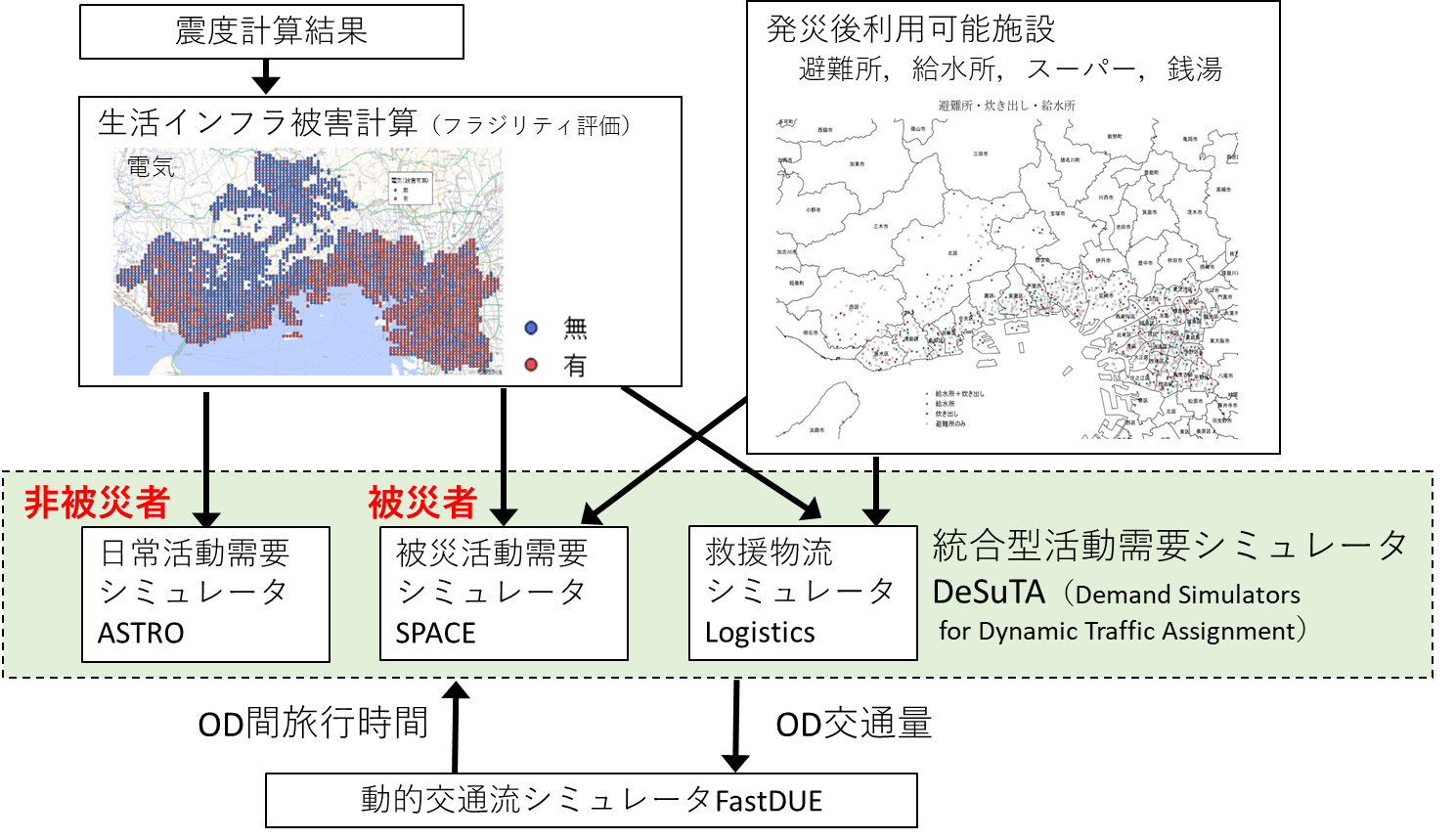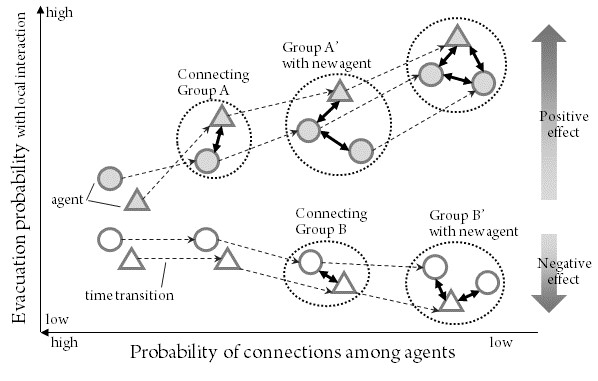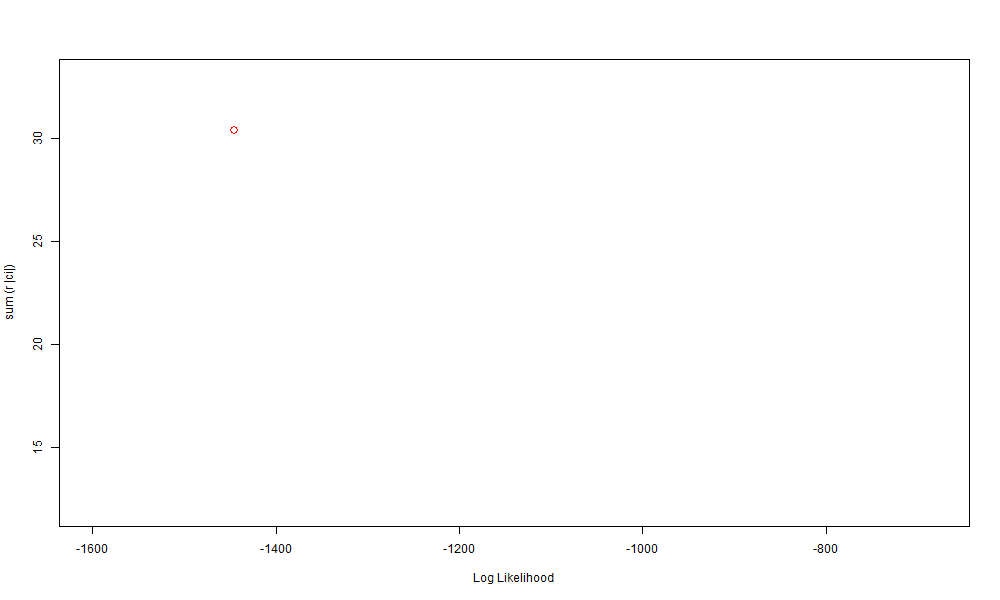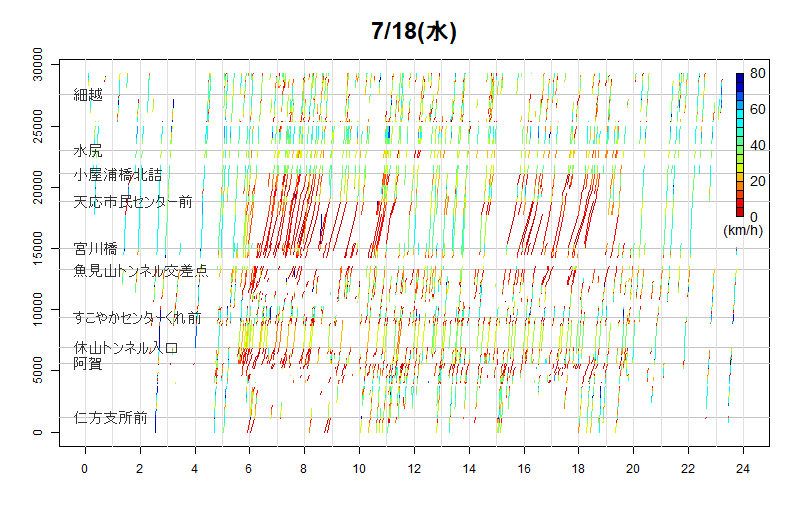

研究テーマ
新しく魅力のある研究をして,より力強く・未来を紡ぐ社会貢献に繋がり,さらに一緒に取り組んだ学生さんが学んだことを生かせる分野にしていくために活動していきたい.そのために,技術の新しいトレンドを取り入れながらも,基礎的な理論・手法を大切にし,両者を融合させることで,交通研究・非定常時計画を発展させていきたいと考えています。
研究の柱としては,これまでの研究の積み重ねを元に「計算レジリエンス移動情報学」と題して,取り組んでいきたいと思っています.具体的には,(1)データ駆動のアプローチによるsoftware2.0志向の交通需要シミュレータ構築,(2)非定常時の相互・動学的な意思決定を表現する行動選択モデルの構築を基とし,(3)非定常行動のシステムマネジメントを試みています(詳細は下記).
また,レジリエンス分野に限らず,自動運転網の都市圏・拠点計画やCV/CAVの相互挙動計算といった次世代交通システムの都市/地域での活用に向けた研究や、地域の未来エネルギーマネジメントやスマートシティ形成、都市空間形成の定量評価(Evidence Based Policy Making)といった研究・活動も、(4)持続可能な地域構築にむけた生活インフラ形成と称して、進めております。
I would like to conduct new and attractive research to contribute to a more powerful and future-oriented society, and also to make the field a place where students who work with us can make use of what they have learned. To this end, I would like to advanced transportation research for usual and unusual-time planning by incorporating new trends in technology while at the same time valuing fundamental theories and methods in the transportation field and integrating the two.
As the prongs of my research, I would like to work on the title of “Computational Resilience Transportation Informatics” based on the accumulation of my past research. Specifically, I am attempting to (1) construct a software2.0-oriented transportation demand simulator based on a data-driven approach, (2) construct a discrete choice model that represents mutual and dynamic decision-making in non-stationary situations, and (3) system management of non-stationary behavior. In addition to the resilience field, we would like to research urban/regional applications of next-generation transportation systems, such as essential planning for automated driving networks and mutual behavior computation of CV/CAV.
研究・開発・実用が次々と進む機械/深層学習アプローチにより,開発過程は,従来の人間がモデルを考えて適用するというプロセスから,集めたデータからモデルがフレキシブルに決定されるプロセス(software2.0)に変化したと言われています(参考).予測面では,非線形にデータに回帰する学習アプローチの優位性は高いですが,一方,データの取得範囲外であっても理論の活用によって説明可能になる現象も存在します.交通計画・制御分野では,大規模データを用いた解析や短期予測は進んでおりますが,まだまだsoftware2.0/データ駆動型の手法が有効活用されているとは言えません。
このような背景の下,これまで開発してきた並列型統合シミュレータ(被災者の逐次的活動を再現する需要シミュレータ(SPACE)と非被災者の活動ツアーをサンプリングにより再現する需要シミュレータ(ASTRO)を同時に計算することで復旧期交通需要を再現)を,software2.0志向に発展させ,データ駆動型のシミュレータ開発を行っています。
交通シミュレータは,様々なコンポネントの集合であり,単純なサロゲイトモデルにより,結果に非線形にフィットさせることに意味は小さく,観測データとユーザー類似性を考慮した準拠集団列挙,行動変容に伴う被サンプリング集合の遷移,深層学習の基礎技術(微分可能プログラミング)を用いたシミュレータパラメータの高速推定などを適用し,開発を進めています。
It is said that the development process has changed from the traditional process where a human thinks of a model and applies it to a process where the model is flexibly determined from the collected data (software 2.0) due to the machine/deep learning approach where research, development, and practical use are progressing one after another. In forecasting, learning approaches that nonlinearly regress to data are highly advantageous. Still, on the other hand, there are some phenomena that can be explained by the use of our theory, even outside the range of data acquisition. In the field of transportation research, analysis and short-term forecasting using large-scale data are progressing, but software2.0/data-driven methods are not yet being used effectively.
On this background, we are developing a parallel integrated simulator (a demand simulator, SPACE, that reproduces the sequential activities of disaster refugees and a demand simulator, ASTRO, that reproduces the activity tours of non-affected people by sampling) to reproduce transportation demand during the recovery period by simultaneously computing the two simulators (see figure below). We are developing data-driven simulators using developing software2.0-oriented approaches.
Since the traffic simulator is a set of various components, it make less sense to fit the results nonlinearly by a simple surrogate model when we evaluate some transportation measures. Therefore, we are developing the simulator by applying choice set enumeration considering user similarity with observed data, transition of the sampling set with behavior change, and fast estimation of simulator parameters using basic deep learning techniques.

復旧期の交通需要シミュレータの概要
Framewrok of Traffic Demand Simulator on disaster recovery period
復旧期の交通需要シミュレータの計算結果(熊本)
Output of Traffic Demand Simulator on disaster recovery period in Kumamoto
これまで,発展的行動モデルについての研究として,災害避難時を対象に,他者との紐帯形成過程の量子メカニズムを通じたモデル化(Urata & Hato (2012)),情報紐帯下の他者との相互作用を考慮した避難行動選択モデル(Urata & Hato 2021),動学的不確実性を考慮した避難開始選択モデル(浦田ら, 2016, Urata & Hato (2024))の構築などを行っています.これらの研究では,行動モデルを発展させることで,非対称的な相互依存的な意思決定過程の表現,先読み避難のための将来リスク認知における時間的異質性の存在などを明らかにし,避難における意思決定に関する柔軟なモデル表現を可能としました.また,こうした研究で培った発展的行動モデルの開発・推定技術は,避難以外にもRide-Hailing Serviceのドライバーの短期的/中期的な意思決定メカニズムの解明(Urata et al. 2021)に関する研究でも応用しています.
相互・動学的な意思決定過程を表現した行動モデルは,情報不確実性の高い状況における意思決定過程の表現に適しています.不確実性の高い状況において,他者の行動選択をあてにした意思決定や,自分の将来の環境を慎重に想定した意思決定が行われやすいからです.これは,日常においても,時空間分解能の小さいミクロなスケールでの行動選択の表現のために,相互・動学的な意思決定モデルが有効であることを意味しています.ミクロな時空間スケールでは均衡的な状況は現れづらく,その場その場での意思決定が生じるからです.
こうした相互・動学的な意思決定過程の実装にむけては,将来効用を考慮する際により有効なパラメータ推定アルゴリズムやシミュレーション再現における相互作用効果の計算方法などが必要となります.そこで,近似的計算や量子アニーリングといった計算アプローチを導入し,発展的な行動モデルについての研究・開発を進めています.
※この研究テーマに関連して、こちらにある通り、筑波大学広報局のPodCastに出演しています。わかりやすい内容になっていますので、興味ある方はお聞きください。
As studies on evolving behavioral models, we have been modeling the process of interaction formation with others through quantum mechanisms during disaster evacuation (Urata & Hato (2012)), constructing an evacuation departure choice model that takes into account interactions with others’ behaviors and dynamic uncertainty (Urata & Hato 2021, Urata & Hato (2024)). In these studies, we have clarified the representation of asymmetric interdependent decision-making processes and the existence of dynamic heterogeneity in the perception of future risk for anticipatory evacuation, enabling flexible model representations of decision-making in evacuation. In addition to evacuation, the development and estimation techniques of evolutionary behavioral models developed in these studies have been applied to research on the short- and medium-term decision-making mechanisms of Ride-Hailing Service drivers (Urata et al. 2021).
Behavioral models that represent mutual and dynamic decision-making processes are suitable for representing decision-making processes in situations of high uncertainty. This is because, in situations of high uncertainty, decisions are more likely to be made based on the behavioral choices of others or based on careful assumptions about one’s future environment. This means that mutual and dynamic decision models are effective in representing action choices on micro scales with a small spatio-temporal resolution, even in usual life. Equilibrium situations are less likely to emerge at micro spatio-temporal scales, and decisions are made on an ad hoc basis.
To implement such mutual and dynamic decision-making processes, more effective parameter estimation algorithms and methods for calculating interaction effects in simulation replications are needed to take future utility into account. Therefore, we are developing advanced behavioral models by introducing computational approaches such as approximate computation and quantum annealing.

災害避難時の世帯間相互作用の時間推移イメージ/Transition of mutual interaction in evacuation situation(Urata & Hato(2021))

時間異質性をもつ動的離散選択モデルのパラメータ推定過程/Parameter Estimation process of the developped dynamic discrete choice model
首都圏中心部では近年大規模な地震被害や大規模水害には遭っていませんが,その可能性は常に指摘されており,十分な準備が必要となります.特に首都直下型地震においては発電所の緊急停止に伴う電力不足,人口密集による避難所・救援物資の不足,細街路ネットワークの閉塞による交通容量低下,公共交通網の停止による事業継続困難性等,様々な生活・経済活動の問題が危惧されています(例えば,東京都による被害想定).
こうした災害復旧期の問題に対して,事前の備えや直後の対応において,(1)で示した災害復旧期の需要シミュレーションの活用により,復旧期の活動予測への貢献が可能となります.2016年の熊本地震で明らかになったように,電気・水・ガスといった生活インフラの被害は被災者による多くの交通需要を生み,都心混雑の要因となり,その予測は欠かせません(Kawasaki et al. (2017)).また,自家用車では到底運べない超過需要を鉄道網の寸断は生むため(力石ら, 2019),道路混雑は激化し,迅速な復旧・復興の障壁になります.加えて,首都圏には人口密集地帯において多数の細街路の閉塞した場合,どう対応するのかといった問題も生じえます.
仮設の救援物資配給所やTDM(時差出勤,代替バス,相乗り促進)等による対策が,これまでの災害ではパッチ的に行われたものの,発災後の即時的な対応には限界があり,都市規模が大きくなるほど,事前計画が必要となります.開発しているASTRO/SPACEは,個々人の活動予測を基に定量的に問題を評価することで,事前計画の検討のベースとなるシミュレータです.一方で,さらに有効な計画を立案する,あるいは,リアルタイムで適した対策を施すためには,シミュレータを下位問題とした二段階最適化の計算が必要となります.二段階最適化問題を解き,復旧期の問題を解くためには,多種の制御変数(避難所立地,配給所営業時間,臨時バス・相乗りのネットワーク設定)の中で適切な制御変数の絞り込みも必要となり,多数の離散制御変数がある場合に有効なモンテカルロ木探索の適用や,その適用のためのシミュレータの高速化に取り組みます.
また,臨時バスや相乗りといった車両輸送における最適ネットワーク輸送計画においては,利用者側の一日の行動パターンを考慮した需要予測が必要となります.災害復旧期という非定常状態の中で,帰りの交通手段が確実になければ,出発することはありません.その確実性を求めて,多くの人が(臨時バス利用を避けて)自家用車利用を選択することも当然の選択になります.こうした不確実性下での意思決定に踏み込み,シミュレータに反映することで,より有効な交通マネジメントの提案を目指します.
Although the central Tokyo metropolitan area has not experienced large-scale earthquake damage or flooding in recent years, the possibility of such events has always been pointed out, and adequate preparations are necessary. In particular, there are concerns that an earthquake of the type directly under the Tokyo metropolitan area will cause various problems in daily life and economic activities, such as power shortages due to emergency shutdown of power plants, shortage of shelters and relief supplies due to high population density, reduced traffic capacity due to blockage of narrow street networks, and difficulties in business continuity due to damage of public transportation networks.
Our demand simulator for the disaster recovery period, as shown in (1), can contribute to the forecast of activities during the recovery period. As the 2016 Kumamoto earthquake revealed, damage to infrastructures such as electricity, water, and gas creates a great demand for transportation by disaster refugees and causes congestion in the city center, making forecasting essential. In addition, the disruption of the railroad network will create excess demand that cannot be carried by only private vehicles. The demand will intensify road congestion and become a barrier to rapid recovery and reconstruction. In addition, the densely populated metropolitan area may face the problem of how to cope with the blockage of many narrow streets.
Temporary relief distribution centers and TDM (staggered work schedules, alternative buses, and carpooling) have been used patchily in past disasters, but there are limits to how quickly these measures can be implemented after a disaster strikes. Our developed ASTRO & SPACE simulators can be used as a base for advance planning by quantitatively evaluating problems based on the prediction of individual activities. On the other hand, to develop more effective plans or take appropriate measures in real-time, it is necessary to perform a two-step optimization calculation using the simulator as a subproblem. In order to solve the two-stage optimization problem as the recovery period problem, it is also necessary to narrow down the appropriate control variables among many kinds of control variables (location of shelters, operating hours of distribution centers, network settings for temporary buses, and carpools). We will work on speeding up the simulator.
In addition, optimal network transportation planning for vehicle transportation, such as temporary buses and carpooling, requires demand forecasting that takes into account the daily activity patterns of the users. In the non-steady state of disaster recovery, if there are no reliable means of transportation to return home, people will not depart. In search of this certainty, it is natural that many people will choose to use private vehicles (avoiding the use of temporary buses). We aim to propose more effective transportation management by entering the decision-making process under such uncertainty and reflecting it in the simulator.

西日本豪雨後の呉・広島間の混雑推移
Day-to-day time-space diagram after a heavy rain disaster
(土木計画学 豪雨災害調査団(平成30年7月豪雨))
人口減・高齢化した地域が増える一方、大都市圏では人口過密のリスク・弊害が指摘され、地方部においては適疎適集(あるいは適散適集)という考え方が注目を集めつつあります。適疎を成り立たせるために何が必要なのか。例えば、これまで一定規模の人口・利用者を前提として成立してきた公共交通や医療は、都市・地域の生活インフラとして欠かせないですが、人口密度減は集約サービスの維持を難しくし、コミュニティバスや訪問診療という新たなサービス形態でさえ、持続できないエリアがあります。そうした中、特にバス・訪問診療という移動を含む事業にフォーカスしつつ、効果的・持続的な運営方法を研究します。
もう一つ、次世代の地域の持続可能性を考える上で重要な問題はエネルギーです。カーボンニュートラルの世界的な浸透の中で、自然エネルギーによる発電可能性・発電力は増しています。一方で、従前の火力発電・原子力発電などの大規模立地型の発電インフラ構築は地域からも受け入れがたくなっています。そうした中、地域内において、自然エネルギー発電・蓄電と電力消費をどうバランスさせていくのか、を研究します。2035年の国内ガソリン車新車販売禁止も控えており、EV充電スタンドやガソリンスタンド立地のマネジメントも含めた地域・都市・住居空間形成の問題にもフォーカスしていきます。
As regions with declining populations and increasing numbers of elderly residents become more common, concerns about the risks and drawbacks of overpopulation in major metropolitan areas are also growing. The concept of “optimal depopulation and concentration” (or “optimal dispersion and concentration”) is gaining attention, particularly in rural areas. What is required to make optimal depopulation viable? Public transportation and healthcare, which have traditionally relied on a certain scale of population and users, are indispensable as urban and regional life infrastructures. However, the decline in population density makes it difficult to maintain these consolidated services. Even new forms of services like community buses and home medical visits are becoming increasingly unsustainable. In this context, our research focuses on effective and sustainable operation methods for businesses that involve mobility, such as buses and home medical visits.
Another critical issue to consider for the sustainability of future regions is energy. Amid the global shift towards carbon neutrality, the potential and capacity for power generation through renewable energy sources are increasing. On the other hand, the large-scale infrastructure construction required for conventional fossil fuel and nuclear power generation is becoming less acceptable to local communities. Our research aims to explore how to balance renewable energy production, energy storage, and energy consumption within regions. In light of the impending 2035 ban on the sale of new gasoline vehicles in Japan, our focus also extends to issues concerning the formation of regional, urban, and residential spaces, including the management of electric vehicle charging stations and gas stations.
訪問診療車の時空間移動データ
Dynamic Origin-Destination data of home visitation vehicle for medical treatment